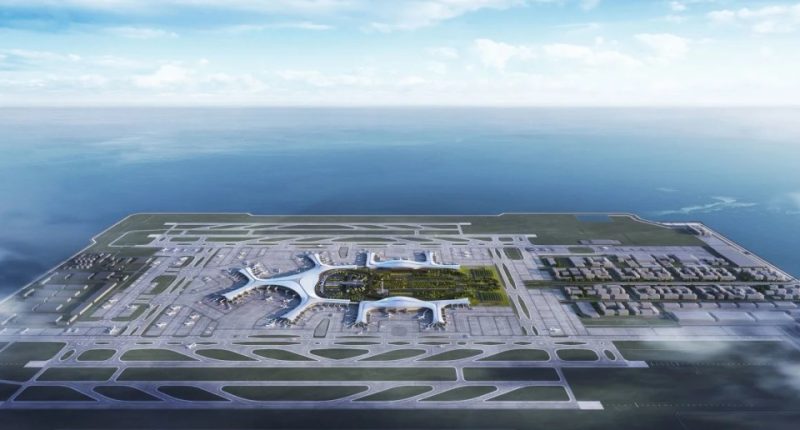Share this @internewscast.com
CHINA is steaming ahead with building the world’s largest man-made island airport.
An expansive travel hub the size of a town is set to be established off the northeast coast, designed to handle 80 million passengers annually—exceeding the entire population of the UK.
The Dalian Jinzhouwan Bay International Airport will cover 20-square-kilometres out in the Bohai Sea when completed.
First flights are expected on the runway in 2035, with capacity winding up to around 540,000 flights each year.
Once the construction of its four runways is finalized, Dalian will eclipse both Hong Kong International Airport and Japan’s Kansai Airport to become the globe’s largest airport on an artificial island.
A recent update from the project’s social media declared: “The nation’s largest offshore airport is gradually rising from the sea level, reminiscent of the sunrise in the east.”
However, progress has not been plain sailing.
The engineer running the project, Li Xiang, said in October: “There have been great challenges to the construction as the project has complex geological conditions, high drilling difficulty and high demand in quality with a tight construction schedule.”
The international travel hub will open with an initial passenger capacity of 43 million annually – but that is expected to double as construction completes.
The new airport addresses limitations at the existing Dalian Zhoushuizi Airport.
Operating for almost a century, the current airport was built during the Japanese occupation and has reached its maximum possible capacity after several recent expansions.
Last year, it served 658,000 international passengers.
Dalian Zhoushuizi sits in a valley surrounded by mountains, which means more planes cannot safely be introduced to the airspace.
The difficult terrain has made navigation challenging for pilots, particularly in poor weather conditions, and the airport has reached its capacity limit after multiple expansions.
The offshore placement of Jinzhouwan Airport solves these challenges by providing more space for expansion and enhancing safety measures, the South China Morning Post reports.
Dalian, in northeastern China, has long been a thriving coastal city with a population of around 7.5 million.
Its strategic port location has led to it becoming is hub for trade with neighbouring Japan and South Korea – and it plays a key role in the oil refining, shipping, logistics, and tourism industries.
The new airport aims to bolster these industries further by improving connectivity and positioning Dalian as a regional air transport hub.
Bigger airports are also a cornerstone of China’s wider aviation ambitions.
The country is on track to surpass the US as the world’s largest air travel market – and massive new infrastructure is needed to accommodate that.
Beijing’s second airport, Daxing (PKX), opened to great fanfare on in October 2019 – the 70th anniversary of the founding of the People’s Republic of China.
At the time, Chinese officials said the country would need 450 airports by 2035, nearly doubling the current count.























